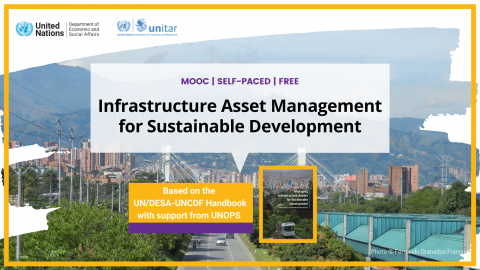
Infrastructure Asset Management for Sustainable Development
This Massive Open Online Course (MOOC) is a self-paced course developed by the United Nations Department of Economic and Social Affairs (UN DESA), United Nations Institute for Training and Research (UNITAR) and the School of International and Public Affairs (SIPA) at Columbia University. The course is based on the UN publication “Managing Infrastructure Assets for Sustainable Development: A Handbook for Local and National Governments” – the result of a joint collaboration of UN DESA, UNCDF and UNOPS.
The Handbook includes inputs from renowned experts from regional development banks, local government associations, relevant UN system entities as well as think tanks and academia. The Handbook provides local and national governments with a set of practical tools to improve infrastructure asset management as well as guidance on how to adapt these tools to the socio-economic and environmental challenges of our time.
It addresses a set of key questions:
- What assets do people need?
- How can these assets be made to last the longest and perform the best?
- How can their potential to save or generate revenue be maximized so as to unlock financial resources for other community needs, now and in the future?
In the answers to these questions lies the key to ensuring the reliability of public infrastructure and services at all levels.
This e-learning course aims to equip policymakers and government officials to find the answers in their specific national and local contexts. It makes a compelling case that ultimately, asset management is a way to align strategic planning with infrastructure and service delivery in the real world. It will equip the learner with a rich set of tools to promote sound, forward-looking asset management that enhances the resilience, sustainability, reliability, and financial viability of infrastructure investments for present and future generations.
It is expected that, by the end of the course, participants will be better positioned to:
1.Describe the principles and dynamics of effective asset management, and how they meet in an asset management framework;
2.Explain the objectives of and be able to apply the UN Asset Management Diagnostic Tool;
3.Describe the design and implementation of Asset Management Action Plans (AMAPs) and be able to develop one in the respective national or local context;
4.Recognize the benefits of an effective asset management information system and outline the steps to develop and implement one;
5.Evaluate and adapt asset management practices for crises such as climate change and public health emergencies;
6.Explain how an enabling legislative and policy environment at the national level can support and sustain asset management at the local level.
The course is divided into two parts: Fundamentals: Infrastructure Asset Management for Sustainable Development (Module 1-4) and InFocus: Infrastructure Asset Management for Sustainable Development (Module 5-8).
Fundamentals:
Module 1. Basic tenets of asset management
Module 2. The dynamics of asset management
Module 3. Assessing asset management needs and capacity
Module 4. Asset Management Action Plans (AMAPs)
In Focus:
Module 5. Capturing and utilising the right data for effective asset management
Module 6. Improving climate resilience within asset management systems
Module 7. Strengthening public health emergency preparedness and response in asset management systems
Module 8. Building a national enabling environment for asset management
This e-learning course is developed in English and consists of eight modules. Each module is developed around the overall learning objectives, as well as second-level learning objectives specific to each module.
Each module combines interactive slides with instructional videos narrated by a Chief Instructor. Throughout the lessons, learners are presented with formative “test your knowledge” questions to check comprehension of the concepts, examples and tools presented. The modules are further enriched by a diverse layer of real-world testimony provided through expert interviews. Experts hail from municipal governments, universities, development banks, local government associations and across the UN system. The modules also comprise open-ended exercise questions (not graded) offered through the lesson section of the learning platform to reflect on the topics and share their experiences.
To assess the effectiveness of the course and the knowledge and skills acquired, each module will have ex-ante and ex-post summative assessments. Learners will answer 3-4 questions at the start of each module to help get a baseline of the learner’s knowledge level to be able to compare with results after taking the module. These will not be graded, nor will there be feedback. Following the module, they will take a 10-question graded assessment that includes the questions they encountered at the beginning. (see more under ‘Certification and feedback’)
This MOOC is available to all interested participants. The main target groups, however, are the central and local government officials in developing countries in Asia and The Pacific, Latin America and the Caribbean and Africa. At the central government level, the target group includes officials from ministries of finance, ministries of local governments, relevant line ministries (e.g., water, health, education) and procurement authorities who are involved in designing asset management policies and regulations at the national level or allocating central government grants for capital investments to local governments. At the local government level, the target group comprises local officials who are responsible for infrastructure asset management, in particular technical experts from the finance, procurement, engineering, water and sanitation, health and education departments, as well as community members such as ward representatives and civil society organizations.

